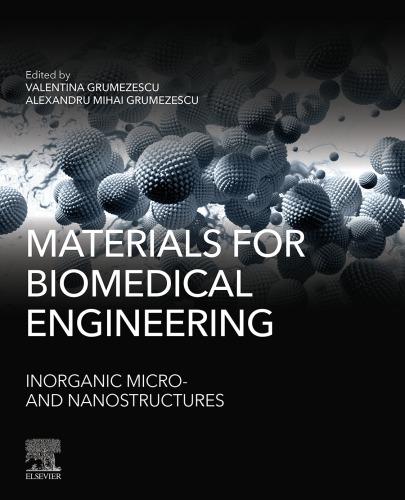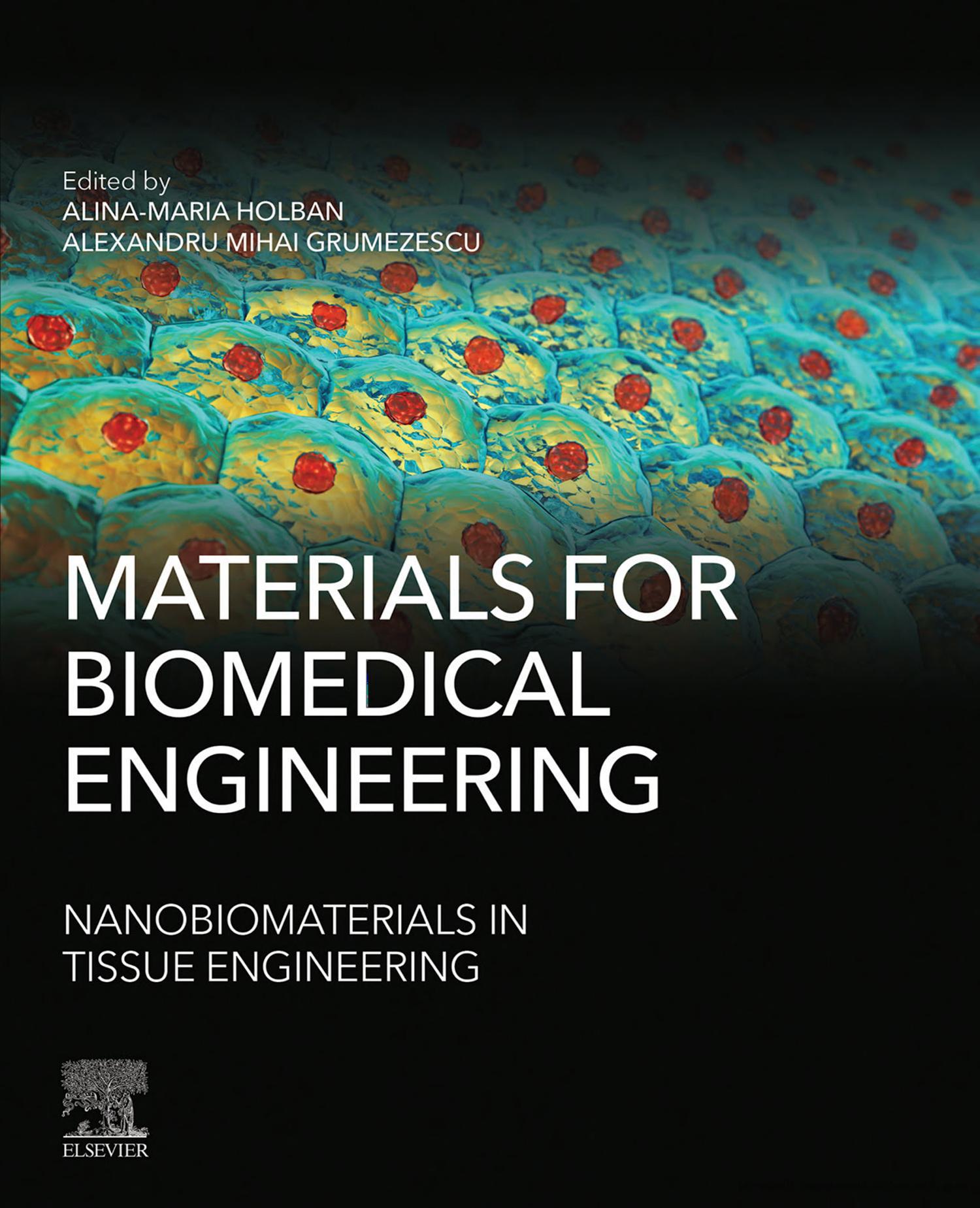ListofContributors
GeetaAggarwal
DelhiPharmaceuticalSciencesandResearchUniversity,GovernmentofNCT ofDelhi,NewDelhi,India
MudasirAhmad
BiopolymerResearchLaboratory,DepartmentofChemistry,JamiaMillia Islamia,NewDelhi,India
SuhailAhmad
BiopolymerResearchLaboratory,DepartmentofChemistry,JamiaMillia Islamia,NewDelhi,India
M.TeresaP.Amorim
CentreforTextileScienceandTechnology(2C2T),DepartmentofTextile Engineering,UniversityofMinho,CampusofAzure ´ m,Guimara ˜ es,Portugal
EcaterinaAndronescu
DepartmentofOxideMaterialsandNanomaterials,FacultyofApplied ChemistryandMaterialsScience,PolitehnicaUniversityofBucharest, Bucharest,Romania
MariaFilomenaBarreiro
LaboratoryofSeparationandReactionEngineering-LaboratoryofCatalysis andMaterials(LSRE-LCM),Braganc¸aPolytechnicInstitute,Braganc¸a, Portugal;CentrodeInvestigac¸aodeMontanha(CIMO),InstitutoPolite ´ cnicode Braganc¸a,CampusdeSantaApolo ´ nia,Braganc¸a,Portugal
SonaliBatra
UniversityInstituteofPharmaceuticalSciences,PanjabUniversity, Chandigarh,India
AmandeepBrar
DepartmentofMicrobiology,SchoolofLifeSciences,CentralUniversityof RajasthanBandarsindri,Kishangarh,India
L.Calabrese
DepartmentofEngineering,UniversityofMessina,Messina,Italy
Juan-Ramo ` nCampos-Cruz
NationalInstituteofTechnologyofMexico/AguascalientesInstituteof Technology,Aguascalientes,Mexico
ThakurPrasadChaturvedi
FacultyofDentalScience,InstituteofMedicalSciences,BanarasHindu University,Varanasi,India
MarietaCostache
DepartmentofBiochemistryandMolecularBiology,FacultyofBiology, UniversityofBucharest,Bucharest,Romania
MadalenaMariaDias
LaboratoryofSeparationandReactionEngineering-LaboratoryofCatalysis andMaterials(LSRE-LCM),FacultyofEngineering,UniversityofPorto,Porto, Portugal
F.Fabiano
DepartmentofBiomedicalSciences,DentistryandMorphologicaland FunctionalImaging,UniversityofMessina,Messina,Italy
HelenaP.Felgueiras
CentreforTextileScienceandTechnology(2C2T),DepartmentofTextile Engineering,UniversityofMinho,CampusofAzure ´ m,Guimara ˜ es,Portugal
AntonFicai
FacultyofAppliedChemistryandMaterialScience,PolitehnicaUniversityof Bucharest,Bucharest,Romania
BiancaGalateanu
DepartmentofBiochemistryandMolecularBiology,FacultyofBiology, UniversityofBucharest,Bucharest,Romania
AlexandruMihaiGrumezescu
DepartmentofOxideMaterialsandNanomaterials,FacultyofApplied ChemistryandMaterialsScience,PolitehnicaUniversityofBucharest, Bucharest,Romania
SungSooHan
SchoolofChemicalEngineering,YeungnamUniversity,Gyeongsan,South Korea;DepartmentofNano,MedicalandPolymerMaterials,Yeungnam University,Gyeongsan,SouthKorea
ArianaHudita
DepartmentofBiochemistryandMolecularBiology,FacultyofBiology, UniversityofBucharest,Bucharest,Romania
SaiqaIkram
BiopolymerResearchLaboratory,DepartmentofChemistry,JamiaMillia Islamia,NewDelhi,India
AnujKumar
SchoolofChemicalEngineering,YeungnamUniversity,Gyeongsan,South Korea;DepartmentofNano,MedicalandPolymerMaterials,Yeungnam University,Gyeongsan,SouthKorea
AshishKumar
SchoolofMaterialsScienceandTechnology,IndianInstituteofTechnology (BanarasHinduUniversity),Varanasi,India
ManishKumar
DepartmentofMicrobiology,SchoolofLifeSciences,CentralUniversityof RajasthanBandarsindri,Kishangarh,India
JoseCarlosLopes
LaboratoryofSeparationandReactionEngineering-LaboratoryofCatalysisand Materials(LSRE-LCM),FacultyofEngineering,UniversityofPorto,Porto,Portugal
ParamjotMaman
ChitkaraCollegeofPharmacy,ChitkaraUniversity,Patiala,India
KaiserManzoor
BiopolymerResearchLaboratory,DepartmentofChemistry,JamiaMillia Islamia,NewDelhi,India
ManjuNagpal
ChitkaraCollegeofPharmacy,ChitkaraUniversity,Patiala,India
AlexandraElenaOprea
FacultyofAppliedChemistryandMaterialScience,PolitehnicaUniversityof Bucharest,Bucharest,Romania
LalitM.Pandey
DepartmentofBiosciencesandBioengineering,IndianInstituteofTechnology Guwahati,Guwahati,India
NidhiPareek
DepartmentofMicrobiology,SchoolofLifeSciences,CentralUniversityof RajasthanBandarsindri,Kishangarh,India
RoxanaC.Popescu
DepartmentofLifeandEnvironmentalPhysics,“HoriaHulubei”National InstituteforPhysicsandNuclearEngineering,Magurele,Romania; DepartmentofOxideMaterialsandNanomaterials,FacultyofApplied ChemistryandMaterialsScience,PolitehnicaUniversityofBucharest, Bucharest,Romania
RajivPrakash
SchoolofMaterialsScienceandTechnology,IndianInstituteofTechnology (BanarasHinduUniversity),Varanasi,India
E.Proverbio
DepartmentofEngineering,UniversityofMessina,Messina,Italy
Norma-AureaRangel-Va ` zquez
NationalInstituteofTechnologyofMexico/AguascalientesInstituteof Technology,Aguascalientes,Mexico
RicardoRangel-Va ` zquez
PCC,HaciendasAve.,Aguascalientes,Mexico
GabrielaRuphuy
LaboratoryofSeparationandReactionEngineering-LaboratoryofCatalysis andMaterials(LSRE-LCM),FacultyofEngineering,UniversityofPorto,Porto, Portugal;LaboratoryofSeparationandReactionEngineering-Laboratoryof CatalysisandMaterials(LSRE-LCM),Braganc¸aPolytechnicInstitute, Braganc¸a,Portugal
LokeshSaharan
Humanoid,BioroboticsandSmartSystems(HBS)Laboratory,Departmentof MechanicalEngineering,TheUniversityofTexasatDallas,Richardson,TX, UnitedStates
VarunSaxena
DepartmentofBiosciencesandBioengineering,IndianInstituteofTechnology Guwahati,Guwahati,India
SumitSharma
UniversityInstituteofPharmaceuticalSciences,PanjabUniversity, Chandigarh,India
IshaniShukla
DepartmentofIndustrial&ManagementEngineering,IndianInstituteof TechnologyKanpur,Kanpur,India
YonasTadesse
Humanoid,BioroboticsandSmartSystems(HBS)Laboratory,Departmentof MechanicalEngineering,TheUniversityofTexasatDallas,Richardson,TX, UnitedStates
RajulVivek
FacultyofDentalScience,InstituteofMedicalSciences,BanarasHindu University,Varanasi,India
V.Vivekanand
CentreforEnergyandEnvironment,MalaviyaNationalInstituteofTechnology, Jaipur,India
SeriesPreface
Inthepastfewdecadestherehasbeengrowinginterestinthedesignandimplementationofadvancedmaterialsfornewbiomedicalapplications.Thedevelopmentofthesematerialshasbeenfacilitatedbymultiplefactors,especiallythe introductionofnewengineeringtoolsandtechnologies,emergingbiomedical needs,andsocioeconomicconsiderations.Bioengineeringisaninterdisciplinary fieldencompassingcontributionsfrombiology,medicine,chemistry,andmaterialsscience.Inthiscontext,newmaterialshavebeendevelopedorreinventedto fulfilltheneedformodernandimprovedengineeredbiodevices.
Amultivolumeseries, MaterialsforBiomedicalEngineering highlightsthe mostrelevantfindingsanddiscusseskeytopicsinthisimpressiveresearchfield.
Volume1. BioactiveMaterials:PropertiesandApplications,offersanintroductiontobioactivematerials,discussingthemainproperties,applications,and perspectivesofmaterialswithmedicalapplications.Thisvolumereviewsrecently developedmaterials,highlightingtheirimpactintissueengineeringandthedetection,therapy,andprophylaxisofvariousdiseases.
Volume2. ThermosetandThermoplasticPolymers,analyzesthemainapplicationsofadvancedfunctionalpolymersinthebiomedicalfield.Inrecentyears therehasbeenarevolutioninthermoplasticandthermosettingpolymerswith medicalandbiologicaluses,whicharecurrentlybeingdevelopedformedical devices,drugdelivery,tailoredtextiles,packaging,andtissueengineering.
Volume3. AbsorbablePolymers,describesthemaintypesofpolymersofdifferentcompositionswithbioabsorbableandbiodegradableproperties.The biomedicalapplicationsofsuchmaterialsarereviewedandthemostinnovative findingsarepresentedinthisvolume.
Volume4. BiopolymerFibers,highlightstheapplicationsofpolymericfibers ofnaturalbiologicalorigininbiomedicalengineering.Suchmaterialsareofgreat utilityintissueengineeringandbiodegradabletextiles.
Volume5. InorganicMicro-andNanostructures andVolume6. Organic Micro-andNanostructures,deal,respectively,withthepreparationandproperties ofinorganicandorganicnanostructuredmaterialswithbiomedicalapplications.
Volume7. HydrogelsandPolymer-BasedScaffolds,discussestherecentprogressmadeinthefieldofpolymericmaterialsdesignedasscaffoldsandtoolsfor tissueengineering.Thetechnologicalchallengesandadvancesintheirproduction, aswellascurrentapplicationsintheproductionofscaffoldsanddevicesfor regenerativemedicinearepresented.
Volume8. BioactiveMaterialsforAntimicrobial,Anticancer,andGene Therapy,offersanupdatedperspectiveregardingnewbioactivematerialswith potentialinthetherapyofseverediseasessuchasinfections,cancer,andgenetic disorders.
Volume9. NanobiomaterialsinTissueEngineering,providesvaluableexamplesofrecentlydesignednanomaterialswithpowerfulapplicationsintissueengineeringandartificialorganapproaches.
Volume10. Nanomaterials-BasedDrugDelivery ,discussesthemostinvestigatedtypesofnanoparticlesandnanoengineeredmaterialswithanimpactindrug delivery.Applicationsfordrug-therapy,andexamplesofsuchnanoscalesystems areincludedinthisvolume.
Thisserieswasmotivatedbytheneedtoofferascientificallysolidbasisfor thenewfindingsandapproachesrelevanttothebiomedicalengineeringfield. Thisscientificresourcecollectsnewinformationonthepreparationandanalysis toolsofdiversematerialswithbiomedicalapplications,whilealsoofferinginnovativeexamplesoftheirmedicalusesfordiagnosesandtherapiesofdiseases. Theserieswillbeofparticularinterestformaterialscientists,engineers,researchersworkinginthebiomedicalfield,clinicians,andalsoinnovativeandestablishedpharmaceuticalcompaniesinterestedinthelatestprogressmadeinthe fieldofbiomaterials.
MichaelR.Hamblin1 andIoannisL.Liakos2 1HarvardMedicalSchool,Boston,MA,UnitedStates 2IstitutoItalianodiTecnologia,Genoa,Italy
Preface
Tissueengineering(TE)hasemergedasapromisingalternativeinthetreatment ofmalfunctioningorlostorgansandtissues.Overthelastfewdecades,TEhas demonstratedanunquestionablepotentialtoregeneratedamagedtissuesand organs.Sometissue-engineeredsolutionshaverecentlyenteredtheclinic,but mostofthepathologiesofinterestarestillfarfrombeingsolved.Thepurposeof thisvolumeistopresentthenewestadvancesregisteredinthefieldonnanobiomaterialswithdirectapplicationsinTEandregenerativemedicine.
Thisvolumeisaninternationalcollection,containing15chapterspreparedby outstandingauthors,asfollows:
Chapter1,Nanobiomaterialsfortissueengineering,byArianaHuditaetal., presentsdifferentcombinationsofnaturalandsyntheticpolymerscurrentlydominantasscaffoldingmaterialsintheTEfieldandthatbyvariousnanofabrication methodsarecapableofgeneratingnanofiberscaffoldsthatbeararemarkable resemblancetothenaturalextracellularmatrix(ECM).Nanoparticlesusedas drugdeliveryreservoirsloadedwithbiologicallyactivemoleculesthatcanfacilitateandacceleratetheregenerationprocesscanbealsocombinedwithother nanoelementsfordesigningandfabricatingTEscaffoldsthatcanbesubsequently employedindifferentTEapplications.
Chapter2,Resorbablebiomaterials:roleofchitosanasagraftinbonetissue engineering,byKaiserManzooretal.,discussestherecentdevelopmentand futureperspectivesinthefieldofnaturalbiopolymerssuchaschitosanandpolyaminosaccharide,whichwidelytakepartasbonesubstitute,having suitablebiomedicalpropertieslikebiocompatibility,antiinflammatory,antimicrobialactivity,biodegradabilityandnontoxicity,immunogenicity,controlledrelease behavior,mucoadhesivenature,andeconomicfeasibility.
Chapter3,Noveltwistedandcoiledpolymerartificialmusclesforbiomedical androboticsapplications,byLokeshSaharanandYonasTadesse,describes twistedandcoiledpolymer(TCP)musclesthataremadeoutofhighlydrawn polymerfiberssuchasnylon6,nylon6,6,andpolyethylene,followingspecific materialprocessingsteps.ThebiomedicaldevicespoweredwithTCPmuscles canaddressthechallengesassociatedwithdesignandapplicationssuchashigh actuationperformanceatlowermaterialcost,whichinturnimprovethequality oflifeforpatients.
Chapter4,Electrospunnanofibersfortissueengineeringapplications,by AlexandraElenaOpreaetal.,focusesontheartificialmaterialsprovidedbyTE tosupportthree-dimensionaltissueformation.Toobtainpropertissueregeneration,itisimportantthatthescaffoldforTEapplicationsimulatethefunctional andalsomechanicalpropertiesofECM.Amongstthelargenumbersofscaffoldingtechniques,electrospinningisaremarkableone,whichisabletoproducenonwovenfibrousstructureswithdimensionalconstituentscomparabletothoseof ECMfibers.
Chapter5,Recentadvancesofchitosancompositesinartificialskin:thenext eraforpotentialbiomedicalapplication,bySumitSharmaandSonaliBatra, focusesonthechitosancompositesexploredforrestoringdamagedtissuesand enhancinghealingprocessbypromotingrateofvascularization.Differenttechniquesusedforphysicochemicalmodulationandvariationinmechanicalproperties arebeingusedtopreparebiocompatiblecomposites,whichmimictheECMand paveapromisingpathwaytobiomaterialfabrication.
Chapter6,Resorbablepolymerfiberreinforcedcompositesinbiomedical application,byParamjotMamanetal.,definestheconceptofcompositesandbiocompositesanddescribestheuseofbiodegradableresorbablepolymersforthe formationofbioresorbablecompositesbycombiningwithdifferentreinforcing elements.Thefabricationandmechanismsbehindthesemodificationsarepresentedandbiomedicalapplicationsincontextofbonetissuerepairarediscussed.
Chapter7,Possibilitiesandperspectivesofchitosanscaffoldsandcomposites fortissueengineering,byManishKumaretal.,emphasizestheassessmentof chitosanscaffoldsandcompositesforengineeringofbloodvessels,bone,articular andtrachealcartilage,skin,skeletalmuscle,neuraltissue,etc.Relationshipsof polymers’structuralpropertiestotheiremploymentintissuehavebeenpresented. Challengesandopportunitiestoimprovepolymerpropertiesforfabricationof cost-effectivematerialsforTEandregenerativemedicinearesummarizedhere.
Chapter8,Hydroxyapatite:aninorganicceramicforbiomedicalapplications, byVarunSaxenaetal.,discussesthebioactivepropertiesofhydroxyapatite,its modificationbyvariouselementaldopingandsubstitutionsalongwiththeplausibleapplicationssuchasdrugdelivery,dentalapplications,stemcelldifferentiation,treatmentofosteomyelitis,andasacoatingmaterialbyrevisiting representativeexperimentalresultsofseveralreferencesalongwithsomepossible strategiestoresolvetheshortcomingsofthispolymer.
Chapter9,Mechanicalbehaviorofhydroxyapatite-baseddentalresincomposites,byF.Fabianoetal.,reviewsconservativedentalcomposites;thephysical, mechanicalandchemicalpropertiesofhydroxyapatitefilledcomposites(e.g.,by varyinghydroxyapatitefillercontent,fillermorphologies,etc.);andoffersacriticaloverviewoftheliterature.Inaddition,adequatepolymerizationofrestorative compositeisafundamentalfactortoobtainoptimalclinicalperformances.Key componentsonthepotentialapplicativeimplicationsofhydroxyapatite-based dentalresincompositeandtodefineasystematicexperimentalselectionofdifferentmethodstoanalyzetheeffectonmechanicalandphysical chemicalpropertiesofhybridceramic-basedcompositesarediscussed.
Chapter10,Molecularstudyofsimulatedbodyfluidandtemperatureonpolyurethane/graphenepolymericnanocomposites:calciumcarbonateandpolymethyl methacrylate(PMMA)usingdynamicsmodelingbyMonteCarloforapplications inboneregeneration,byJuan-Ramo ´ nCampos-Cruzetal.,describesthe approachestodesigningnewbiomaterialswithspecificpropertiesbyanalyzing thebehavioratthenanoscale.Theauthorshavedevelopeddifferentmodelsof computersimulationasmoleculardynamics,dynamicsofquasi-classicalspin,
Langevin’sandBoltzmann’sequations,suchasMonteCarlosimulations,which areperformedthrougharepeatingrandomsamplingandsimultaneouslyastatisticalanalysisisperformedtoobtainbetterresults.
Chapter11,Newinsightsintonanohydroxyapatite/chitosannanocomposites forbonetissueregeneration,byGabrielaRuphuyetal.,revealsthenewestprogressmadeontheuseofnanohydroxyapatite/chitosannanocompositesfortheir applicationinhardtissueregeneration.
Chapter12,Productionofpolymer bioactiveglassnanocompositesforbone repairandsubstitution,byHelenaP.FelgueirasandM.TeresaP.Amorim, reviewsnewtrendsinbioactiveglass(BG)forboneandtissueregeneration.The mostpromisingBG polymercombinationsandtheadvantagesintroducedin boneregenerationbythesecompositesareenumerated,andthischapterexplores someofthemostcommonlyusedsynthesistechniquesappliedtotheproduction ofBG polymercomposites.
Chapter13,Bioactiveglass basedcompositesinbonetissueengineering: synthesis,processing,andcellularresponses,byAnujKumarandSungSooHan, reviewsthesynthesisandprocessingofBGsandtheirusewithvariouspolymers ascompositebonematerialsforload-bearingcapacityandexcellentcellviability duringbonetissueregeneration.
Chapter14,Mechanicalandwearpropertiesofnanotitaniumbaseddental compositeresin,byRajulViveketal.,summarizesthestudyofmechanicaland wearpropertiesofPMMAresinsmodifiedbynano-Tifillersalongwiththerecent gistofotherdentistrymaterials.Themainpurposeinconservativedentistryhas beentorestorethemissingtoothsubstancebyarestorativematerialwithharmonizingsignificantpropertieslikemechanical,physical,thermal,andwear properties.
Chapter15,Invitroandinvivotechnologies:anuptodateoverviewintissue engineering,byRoxanaC.Popescuetal.,presentsanuptodateoverviewofthe invitroandinvivotechnologiesintheTEfield,withapplicationsinthedevelopmentofbettertumormodelsforthestudyofmechanismsandpossibletherapeutic approaches.
Alina-MariaHolban1 andAlexandruMihaiGrumezescu2
1FacultyofBiology,UniversityPolitehnicaofBucharest,Bucharest,Romania
2FacultyofAppliedChemistryandMaterialsScience,University PolitehnicaofBucharest,Bucharest,Romania
1
ArianaHudita,BiancaGalateanuandMarietaCostache DepartmentofBiochemistryandMolecularBiology,FacultyofBiology,Universityof Bucharest,Bucharest,Romania
1.1 INTRODUCTION
Tissueengineering(TE)representsacuttingedgebranchofregenerativemedicine,whichreliesonthelatestprogressesreportedincellbiology,materialscience,andbiomedicalengineeringtodevelopaproperbiologicalsubstitute capableofrestoring,maintaining,orimprovingthegenuinefunctionofadefectivetissue(Walmsleyetal.,2015).
RegardlessofthenumerousdefinitionsavailableforTE,itiswidelyacknowledgedthatthekeyelementsthatrepresentthefoundationofthisfieldarerepresentedbycells,scaffolds,andgrowthfactors(Pereiraetal.,2011)thatare generallyknownasthe“tissueengineeringtriad.”However,recentstudiesimply aTEscaffold-freeapproach,whichpromotesthelackofthetridimensional(3D) exogenoussupportmaterialrequiredfortissueregeneration.Indeed,themodern scaffoldlessapproachcontradictsthebasicprinciplesoftraditionalTE,butthis regenerativestrategycomeswithapoormechanicalsupportfortissueregenerationandsoitaddressesasignificantlimitednumberoftissuedefects,focusing mainlyondefectivecartilagesorvascularregeneration.Thereby,forthemost partscaffoldsareplacedinthespotlightoftheregenerativemedicinefieldas theygenerallyrepresentamandatoryelementtoobtainanengineeredtissue.
ModernapproachesinTEandregenerativemedicineenvisagetheintegrationof nanotechnologyinthedevelopmentofnanostructuredbiomaterialswithsuperior regenerativepotential.Thequiterecentintegrationofnanotechnologyintomedicine isreferredtoasnanomedicineanditbringsexcitingopportunitiestothedevelopmentofinnovativeapproachesinthefieldofdrugsdeliverysystemsdevelopment, imagingtechniques,TE,andregenerativemedicine.Nanotechnologyenablesthe designandfabricationofnanoscaledbiocompatiblescaffoldsandfurthercontrols thereleaseofbiologicalfactorsinspaceandtime,controllinginthiswaythecell behaviortofinallygenerateimplantabletissues.
Invivo,cellswithintissuesaresurroundedbyanextracellularmatrix(ECM), anaturalwebofhierarchicallyorganizednanofibers(StevensandGeorge,2005), MaterialsforBiomedicalEngineering:NanobiomaterialsinTissueEngineering. DOI: https://doi.org/10.1016/B978-0-12-816909-4.00001-4 © 2019ElsevierInc.Allrightsreserved.
whichprovidessupporttothecellsanddirectstheirbehavior.Furthermore,the ECMplaysakeyroleinactivatingandregulatingthestorageandreleaseofa widerangeofbiologicalactivefactors(TaipaleandKeski-Oja,1997)likegrowth factorsforexample.Recentadvancesinnanotechnologyenvisagethedesignand developmentofananoscalebiomimeticmicroenvironment,whichprovidesan analogtonativeECMtocells.Consequently,nanostructuredmaterialsareableto mimictissue-specificbioenvironmentsbydesigningbioconstructswithspecific biochemical,mechanical,andelectricalproperties.Thereforedenovotissuecan beengineeredbyemployingthesenanostructuresforenhancedcelladhesion, growth,anddifferentiation.Additionally,theinteractionofthecellswiththese biomimeticnanopatternstriggersdynamicECMchangesandalsocaninducethe differentiationofstemcellswithouttheadditionofexogenoussolublebiochemicalfactors(Kimetal.,2012).Nanosizedmaterials,ontheotherhand,have attractedmuchattentionformedicalapplicationsprimarilyduetotheirlargesurfacetomassratiothatoffersthemuniquefeaturesliketheabilitytoadsorband carrycompounds,chemicalreactivity,energyabsorption,andbiologicalmobility (Murthy,2007).
Independentofthechosenmaterialorfabricationmethod,thescaffoldis designedbasedonaminimalnumberofcharacteristicsthatsupportitsprospectiveuseforinvitroproductionofengineeredtissueandfurtherinvivoapplications.Briefly,ascaffoldneedstobebiocompatible,biodegradable,andconsistent withthemechanicalrequirementsofthetissuethatistargetedforregenerationor replacement(ZhouandLee,2011).
Thereforetheartofgeneratinganidealengineeredtissuereliesonobtaining theappropriateblendoftheTEtoolsavailabletoproduceafinalbioconstruct withmechanical,physical,andbiologicalproprietiesascloseaspossibletothe nativecharacteristicsofthedefectivetissue.Sinceinvivothecellsareshielded withinanECM,thedesignprocessisusuallybasedonthemostpromisingbiomaterialscapabletomimictheECMofthedamagedtissue.
1.2 APPLICATIONSOFNANOENGINEEREDSCAFFOLDSIN REGENERATIVEMEDICINE
Numerousstudiesshowthattheinteractionbetweencellsandtheirmicroenvironmentmaytriggerthecytoskeleton’sreorganization(Dinescuetal.,2015)aswell asspecificcellsignalingthatregulatesthefateofthecell.Inthiscontext,nanostructuredscaffoldsthatmimicthetissue-specificmicroenvironment(similarbiochemical,mechanical,electricalpropertiesandtopographytothoseofnative tissues)haveattractedmuchattentioninnanotechnologyforTEandregenerative medicineastheyareabletoenhancecelladhesion,proliferation,andstemcell differentiation(Yangetal.,2014).Consequently,thesenanodevicesseemtobe abletodirectcellularbehaviorfromcelladhesiontogeneexpression.
ECM-likearchitecturesareproducedbyvariousmethodssuchasnanopatterning,electrospinning,self-assembly,conjugationofadhesionmoleculestothe matrix,etc.(Kimetal.,2010a).Additionalincorporationofnanomaterialslike carbonnanotubes(CNTs),nanowires,ornanoparticles(NPs)inthesearchitecturesmodulatethepropertiesofthebiomaterial(Dviretal.,2011).Forexample, Galateanuetal.(2015) describedthedevelopmentofabacterialcelluloseand magneticNPsnanocompositebiomaterialforefficientchronicwoundshealing, while Youetal.(2011) publishedapaperdescribingthedevelopmentofanelectricallyconductivehybridhydrogelscaffoldbasedongoldNPssynthesized throughoutapolymertemplategel.Nanotopographicalvariationsinthecelladhesionsubstratecanregulatedifferentiationofhumanmesenchymalstemcells towardsadipocytes,chondrocytes,orosteocytes(Ahnetal.,2014;Dinescuetal., 2014,2015).
Understandingthemechanismsregulatingthepathwaysinvolvedin cell matrixinteractionsiscrucialfordesigningfurtherimprovedbiomimetic nanoscaffoldsthatcanevenreleasebioactiveagentsinacontrolledmanner.
1.3 NANOSTRUCTUREDPOLYMERSASTISSUE ENGINEERINGSCAFFOLDS
Asaforementioned,scaffoldsplayapivotalroleinthedevelopmentofnovel engineeredtissuesthataimtorestore,replace,orregenerateimpairedtissues (RouchiandMahdavi-Mazdeh,2015).Thechoiceofthematerialunderlyingthe scaffoldsynthesisisdependentonthefinalapplicationasitisessentialtomatch thenativebiologicalandstructuralcharacteristicsofthedamagedtissuethat requiresregenerationorreplacement.Despitethevarietyofmaterialsavailableat themomentforscaffoldfabrication(Ratneretal.,2004),biopolymersrepresent thefavoriteselectionfordevelopingbiologicalsubstitutesforregenerativepurposes.ThemainbiocompatibleandbiodegradablepolymersusedforTEapplicationsincludenaturalpolymerssuchascollagen,chitosan,silk,alginate,fibrin, gelatin,orsyntheticpolymers,countingamongthemostusedpolylacticacid (PLA),polyglycolicacid(PGA),poly-ε-caprolactone(PCL),poly(lactic-co-poly (glycolicacid))(PLGA),poly(L-lacticacid),polyacrylamide,polyurethane(PU), polyethyleneterephthalate,polymethylmethacrylate,polyethyleneoxide,and polyvinylalcohol(PVA).
Basedontherapiddevelopmentofthenanotechnologiescurrentlyavailable forproducingnanoscaledscaffolds,polymerscanbeusedasbulkmaterialtoproducebi-(2D)or3Dnanoscaledsystemsinformofnanocomposites,nanogels,or nanofibers.Amongtheseformulations,polymersarecurrentlybeingintensively usedforobtainingnanofibrousscaffolds,throughdifferentsynthesisstrategies suchaselectrospinning,self-assembly,orphaseseparation.Electrospinningtechnique(Lietal.,2002)iscurrentlythemostintensivelyusedmethodforobtaining
polymericnanofibersduetothefactthatitisarelativeeasymethodandoffers increasedflexibilityoftheinputmaterial.Evenifthescaffoldsfabricatedby electrospinningresemblethenaturalECMintermsofmorphology,theyusually presentasmoothsurfaceandfailtoprovidecellsthenanostructuretopography thatfeaturesinvivothenaturalcollagennanofibrils;thismattercaneasilyimpact inanegativemannercellattachment,growth,andproliferation(Fangetal.,2013; Fiedleretal.,2013),soduringthescaffoldingprocessotherreinforcementstrategiescanbeusedtotailorthebiologicalresponseofcellsduringscaffold interaction.
1.3.1 NATURALANDSYNTHETICPOLYMERS
Tobenefitfromtheirenhancedbiocompatibility,naturalpolymershavebeen widelyusedfornanostructuredpolymericscaffoldsynthesis.Theuseofnatural polymersaspartofthescaffoldmanufacturingprocessrepresentasmartapproach sincetheyexhibitseveralimportantadvantagesbeyondtheirexcellentbiocompatibility(Sabiretal.,2009).Naturalpolymersarebiologicallyactive,thereforethey aremorelikelytopromotecellularadhesionandsustaincellularproliferationand differentiationtowardsthecellulartypeneeded.More,naturalpolymersarebiodegradableandthedegradationratecanbeeasilycustomizedbycross-linking withdifferentagentstoadjustthescaffolddegradationrateconsistentwiththe targetedapplication.However,issueslikeimmunogenicityandtheirpoor mechanicalpropertiesthatlimittheirTEapplicationsstillneedtobeaddressed (Sanoetal.,2003;Saravananetal.,2016).
Themostcommonoptionforgeneratingnanostructuredscaffoldsfromthe vastvarietyofnaturalpolymersavailableiscollagen,sincethisproteinisthepredominantstructuralproteinintheECManditcanbeeasilyisolatedandpurified. Collagenexhibitsseveraluniquecharacteristicsthatconvertthisproteinintoan idealmaterialforscaffoldfabricationsuchasexcellentbiocompatibility,immunogenicity,andanaturalcapacitytopromotecellularadhesionandproliferation. Thuscollagenhasbeenexhaustivelyusedforbiomedicalscaffoldapplications suchaswoundhealing(Maetal.,2003),cartilageregeneration(VazquezPortalatinetal.,2016;Mohanetal.,2018; Halilietal.,2018)boneTE (Montalbanoetal.,2018;Wangetal.,2018a;Heetal.,2018),andneuraland vascularreconstructivestrategies(Dingetal.,2011;Yanetal.,2018;Schuh etal.,2018).Withthehelpofthecurrentnanotechnologiesavailable,collagen caneasilybereconstitutedintonanofibrousstructuresthatmimicthenativeECM ofthetissues.Gelatin,aderivativeofcollagenobtainedbyhydrolysisisbecominglatelymoreappealingthancollagensinceitpresentsalowerantigenicityas comparedwithitsprecursor,butcanstillnaturallyfacilitatecellularadhesion, proliferation,anddifferentiation(Malafayaetal.,2007).
Pristinecollagenwassuccessfullyemployedinstudiesaimingatnervetissue regenerationscaffoldfabrication.Forexample,Timnakandcolleaguessynthetizedananofibrousporousscaffoldbasedoncollagenandchondroitinsulfate
usingelectrospinningasmethodforgeneratingpolymericnanofibers.Theuseof chondroitinsulfateasglycosaminoglycancomponentofthefinalcomposite obtainedwassustainedbythepotentialofthisbiologicalmoleculetosupportand acceleratetissueregenerationandtopromotecell scaffoldinteraction(Shaoping etal.,2005,2007).More,forincreasingthebiocompatibilityofthescaffold,genipinwaspreferredascross-linkingagentattheexpenseofthewidelyusedglutaraldehydeduetoitssignificantreducedcytotoxicity.Thepotentialofthescaffold tosustaincellularattachmentandtosustaincellularviabilityandproliferation wasinvestigatedusingtheSK-N-MChumanneuroblastomacelllineasinvitro cellculturemodel.Resultsshowedthatthenovelscaffoldobtainedpresentsa goodbiocompatibilityandeasilyallowedtheattachmentofthehumanneuroblastomacells.Also,controllingtheorientationofthepolymericfibersthroughout thesynthesisprocesspresentedapositiveimpactuponthecellularoutgrowthorientation(Timnaketal.,2011).
Silkfibroin(SF)representsafibrousproteinthatcanbeeasilyisolatedfrom silk,apartfromitssecondaryglobularcomponentsericin.EvenifalargespectrumofnaturalsourcesisavailableforharvestingSF, Bombyxmori isextensively usedastheprimaryisolationsourceatthemoment.Generally,forTEapplicationsSFwassubjectedtoascaffoldprefabricationstepcalleddegumming(Kim etal.,2017a)tobetotallycleansedfromsericin,whichcanalteritsnoncytotoxic potential.Althoughdegummingwasinitiallyanessentialstepinscaffoldfabricationprotocols,recentstudiesreportsericinasabiocompatiblematerialforTE, sinceitgeneratestoxiceffectsonlyincombinationwithSF.Properlydegummed SFisapromisingcandidateforTEapplicationssinceitdistinguishesexcellent mechanicalproprieties,unlikelyfromothernaturalpolymers.SFisabiocompatibleandbiodegradablepolymer,whichtriggersaminimalinflammatoryresponse uponimplantation(Faokhietal.,2016;Juetal.,2016).ThedegradablerateofSF scaffoldisslowduetotheinvivoproteolyticactivity,butitcanbecustomized dependingonthetargetedTEapplicationbymodifyingdifferentmechanicalsettingsofthescaffoldsynthesisprocedure(Horanetal.,2004).SFhasbeensuccessfullyemployedindifferentTEapplicationssuchascardiovascularTE(Zhang etal.,2010a).
Toincreasethemechanicalandbiologicalproprietiesofthehumanamniotic membrane(HAM)asbioengineeredskinsubstrate,thedeepithelizedHAMwas reinforcedwithelectrospunSFnanofibers.Thenovelbilayerscaffoldobtained hasshownsuperiormechanicalandinvitrobiologicalproprietiesascompared withpristineHAM,beingagoodcandidateforskinTE(Arastehetal.,2016).
Amicro/nanoporouspatternofaSFscaffoldwasobtainedby Xiaoetal. (2017) thatpresentedamodifiedsalt-leachingprocessforgeneratingnovelSF scaffoldsthatpresentedanenhancedpotentialforstimulatingcellproliferation anddifferentiationofbonemarrowmesenchymalstemcellsascomparedwithSF scaffoldsobtainedbyconventionalmethods.
AsimpleSF/hydroxyapatite(HAp)scaffoldcanpromoteosteoblastadhesion andsustaintheearlystageosteogenicdifferentiation(Weietal.,2011).Recently,
Niuetal.fabricatedapotentialboneTEscaffoldcomposedbyamixofnanofibrousSFwithHApNPsandbone-morphogeneticprotein2(BMP-2)toboostthe osteoinductivepotentialofthesynthetizedscaffold.TheadditionofHApand BMP-2upgradesthemechanicalcharacteristicofsimpleSFscaffoldandintensifiesthebioactivityofthescaffold;thebone-marrowstemcells(BMSCs)succeededtoattachtothesurfaceandpresentedanexcellentviability,followedby successfulinvitroosteogenicdifferentiation(Niuetal.,2017).
OtherbiocompatibleandbiodegradablenaturalpolymershavebeenintensivelyusedforTEscaffoldfabrication. Chenghongetal.(2017) fabricatedaelectrospuncellulosenanofiberscaffoldimprovedwithnanoHApforbonetissue regenerationthatshowedgoodbiocompatibility,withlowcytotoxicityevenat highconcentrationsofnanoHAp.
Zangetal.synthetizedbacterialcellulose(BC)tubesfrom Gluconacetobacter xylinum usingforthefirsttimepolydimethylsiloxaneasfabricationmold.This methodseemstobeviableforobtainingtubularscaffoldsforvascularTEasthe obtainedscaffoldspresentedgoodmechanicalproprietiesandhighthermalstability,togetherwithgreatbiocompatibilityasrevealedbytheinvitroviabilityand proliferationassaysperformedonvessel-connectedcellcultures(endothelialcells, smoothcells,andfibroblasts).TheinvivoresultssustainedthescaffoldbiocompatibilityandrevealthattheBCtubeslackabilitytoinduceanimmuneresponse (Zangetal.,2015).
Forfabricatingantibacterialwounddressings,whichisextremelyusefulto amplifytheregenerationprocess, Liakosetal.(2017) fabricatedelectrospunfiber padsofcelluloseacetatecombinedwithdifferentessentialoilsthatpresented greatantimicrobialproprietieswhentestedagainstmicrobialspeciesthatareconstantlypresentininfectionsandparticularlydifficulttotreat,while Tabaiiand Emtiazi(2018) synthetizednontoxicbacterialcellulosemembranesimpregnated withsilverNPsthatpresentedgreatbiocompatibilityandholdgreatpromisein enhancingtheantibacterialactivityofclassicalantibioticssuchasgentamicin.
Syntheticpolymers,mainlyPGA,PLA,andPCL,havealsobeenemployedin designingTEscaffolds,sincethecostsinvolvedforscaffoldfabricationare reducedcomparedwiththeexclusivelynaturalpolymericscaffoldsandalso becausetheyareeasiertoprocess.More,themechanicalproprietiesofsynthetic polymerbasedscaffoldsareonthewholesuperiorascomparedwithnaturalones, buttheylackabilitytoprovidethenecessarybiologicalcuesforcelladhesion, usuallyduetotheirhydrophobicnature.Evenifthedegradationproductsare representedbymetabolitesnaturallypresentinthehumanbody,theacidnature ofthedegradationproductscanstilltriggerinflammationreaction,butusuallythe immunereactionscannotbecomparedinmagnitudewiththoseactivatedbynaturalpolymers(Liuetal.,2012).Mainlyduetotheirlackofbioactivity,synthetic polymersareblendedwithpolymersisolatedfromnaturalsourcesforasynergisticeffectthatcanimprovethefinalmechanicalandbiologicalperformanceofthe TEscaffoldfabricatedorfunctionalizedwithbioactiveelementsforthesamepurpose(Heetal.,2009;Liuetal.,2012;Guoetal.,2015).
1.3.2 BLENDEDPOLYMERSFORSMARTHYBRIDSCAFFOLD FABRICATION
ThustofabricateanidealscaffoldforTEapplications,thelatesttrendistoefficientlyblendnaturalandsyntheticpolymerstofullybenefitfromthestrengthsof bothclassesofpolymers.Generally,thesyntheticpolymerbasedscaffoldspresent excellentmechanicalproprietiesrequiredfordifferentTEapplications,butlack abilitytoencouragecellularadhesionandusuallyexhibitpoorbiocompatibility. Incontrast,naturalpolymersproducehighlybiocompatibleandbioactivescaffoldsthatprovidecellsbiologicalcuesforattachmentandfurthersustaincellular proliferationanddifferentiation.Thereforeseveralrecentstudieshavebeencarriedoutonfusednaturalandsyntheticpolymersscaffoldsthatcanincreasethe oddstoobtainECM-likeconstructsintermsofmechanicalandbiologicalproprieties.ThisapproachhasbeensuccessfullyusedforalargenumberofTE applications.
Forexample,Shenetal.evaluatedthesynergiceffectofcombiningtwo nanoscaledstrategiesforobtaininganeffectivescaffoldintendedfordentinTE;it hasbeenshownthatPLA,usedfrequentlyforperiodontitistreatment(Wuetal., 2010;Lietal.,2013)producesaninflammatoryresponsegeneratedbyitsdegradationproducts(Wuetal.,2015)andalsopresentsapoorhydrophilicitythatcan alterthescaffoldpotentialtosustaincelladhesion,proliferation,anddifferentiation(Kimetal.,2006;Khorasanietal.,2008).Indeed,endorsingthePLAnanofiberswithchitosanNPsovercomesthesedrawbacks.
Forskinregenerationpurposes,Sharifandcolleaguessuccessfullyfabricateda collagen-coatedPCLscaffoldthatshowedasignificantlyimprovedcelladhesion andproliferationsupportforhumanendometrialstemcellsascomparedwithsimplePCLscaffold(Sharifetal.,2018).
Electrospunnanofibersgeneratedfrombacterialcellulosehavebeenusedas reinforcementofPVA-basedscaffolds(Palaninathanetal.,2018),obtaining increasedbiocompatibilityconfirmedbyL929mousefibroblastadhesionandproliferationforthefinalPVA/bacterialcellulosescaffoldthatcanbefurther employedindifferentTEapplications.
AnovelPCL/collagen/nanobioglasswashighlightedasanexcellentcandidate innervetissueregenerationasitpromotestheinvitrocapacityofendometrial stemcellstoadhereandproliferate(Mohamadietal.,2017).
Evenifseveralstudiesthatconfirmthebenefitsofusingnanofibrousscaffolds andsustaintheirprospectiveuseinTEareavailable,thisapproachpresentsdisadvantagesthatcanhamperthedesignofafinalECM-mimicking3Dscaffold. Regardlessofthechoiceofmaterialforfabrication,theconventionalnanofibrous scaffoldobtainedprovideasuperficialporousstructureconsistingofporesof verysmallsizethatcanobstructthecellularmigrationprocesswithinthescaffold (Kimetal.,2010b;Sissonetal.,2010;)anddiminishthecellularinfiltration, whichleadstofabricatingascaffoldthatiscapableonlyofgenerating2Dbioconstructs.Toovercomethisissuenanostructuredpolymerscanbeeasilymerged
withmicrostructuredones(Tuzlakogluetal.,2011),usuallyusingdualextrusion electrospinningtechnique.
Forinstance,Kimetal.fabricatedacompositescaffoldblendingmicro-PCL withnano-SFtopromoteboneregeneration.ComparedwiththesimplemicrofibrousPCLscaffold,theadditionofnano-SFconsiderablyimprovedthebioactivityofthenovelscaffoldsynthetizedintermsofcellularadhesion,proliferation, andosteogenicdifferentiationofhumanmesenchymalstemcells.More,when implantedinvivointhecalvarialdefectsofrabbitsthescaffoldstimulatednew boneformation(Kimetal.,2015).
Alsoforbonetissueregeneration,Kw aketal.usednanofibrouscollagen inthedesignofahybridnano/microscaffoldtoenhancethescaffoldpotentialtostimulatecellattachmentandsustainproliferationanddifferentiation. MicrofibrousPLGAmesheswerealternatedwithnanofibrousmeshesofcollagenandendorsedornotwithnanorodsofHApandshowedasignificantly increasedpotentialinsustainingcellula radhesion,proliferation,andosteogenicdifferentiationofMC3T3-E1cel lsascomparedwiththesimplePLGA scaffold( Kwaketal.,2016 ).
Sarkarandteammatesfabricatedalayerednano/microfibrouschitosan/collagenscaffoldasdermalsubstitute.Thefutureuseofthisscaffoldwithcombined micro-andnanoarchitectureinskinTEwassustainedbytheexcellentbiocompatibilityestablishedinvitroonfibroblastsandkeratinocytes(Sarkaretal.,2013).
1.3.3 OTHERNANOSTRATEGIESCOMBINEDWITHPOLYMERIC SCAFFOLDS
EvenifthepolymericscaffoldsareintensivelyusedinTE,thescaffoldingprocessneedstobedynamicallyadaptedtothediverseandgrowingneedsofregenerativemedicinesoitisimportanttotakeadvantageofotherpromisingmaterials availablethatcanboosttheperformanceofthesynthetizedscaffolds.Inthis view,differentmaterialssuchasCNTsorcarbonnanofibers(CNFs),HAp,and NPshavebeenexploitedfornanocompositedesigningandprocessing,usuallyfor TEapplicationsthatrequirehighmechanicalstrength.Forfabricationofpolymericbasedhybridscaffolds,theamountofCNTsorCNFsembeddedinthefinal constructneedstobecarefullyselectedandoptimizedsinceitcanaffectthefiber diameter,theoverallmechanicalproprieties,andthebiologicalyieldintermsof celladhesion,proliferation,ordifferentiation.Forscaffolding,CNTscanbeused informofsinglesheetsofgraphiteknownassingle-walledCNTs,butthepreferredoptionremainsthemultiwalledcarbonnanotubes(MWCNTs)thatareconstructedbymultipleconcentricgraphitecylindersandpresentlargerdiameters thatthesingle-walledtype(Linetal.,2004).
TheCNTsandCNFsarehollownonbiodegradablematerials,withoutstanding physicalproprieties,characterizedby nanosizes,theCNTsbeingsmaller(1 30nm) indiameterascomparedwithCNFs(50 200nm).Bothnanostructuresarewidely
usedforbiomedicalapplicationsinnanocompositedesigningandsynthesis,usually asreinforcementagentsforpolymericscaffoldstargetinghardTEapplications. Despitetheirpopularityforosteoinductivescaffoldsynthesis,CNTshavebeen usedsuccessfullyastissuescaffoldsforcardiacconstructs(Wickhametal.,2014; Renetal.,2017;Hoetal.,2017;Sunetal.,2017)ornerveregeneration(Kuzmenko etal.,2016;Singhetal.,2016;Vallejo-Giraldoetal,2016;Lvetal.,2017; Leeetal.,2018).
SinceCNTs/CNFs-basednanocompositesaremechanicallyrobust,itisnot surprisingthatmostoftheapplicationsdevelopedareaimedatbonetissueregeneration.Byexternalelectricalstimulustheosteoblasts’biologicalactivity,adhesion,proliferationpotential,andosteogenicdifferentiationprocesscanbe modulatedsothegreatconductivityofCNTscanbeexploitedtoimprovethe osteoblasts’performance(Mengetal.,2013).More,CNTscanbeeasilyfunctionalizedwithavastvarietyofbiomoleculestodiminishtheircytotoxicpotential andproinflammatorypotential,makingtheCNTsaremarkablebiocompatible nanomaterialforTE(Dumortieretal.,2006).
Abdorrezaetal.(2017) synthetizedagelatin/chitosanscaffoldreinforcedwith functionalizedMWCNTsthatpresentedgoodporosity,superiormechanicalproprieties,andfacilitatedbiomineralization,beingasuitablecandidateforboneTE.
ShresthaandcolleaguesfabricatedanelectrospunPUscaffoldreinforced withfunctionalizedMWCNTsandzincoxide(ZnO)NPsthatpresenteda remarkablemechanicalprofile,with enhancedelectricalconductivity.The biocompatibilityofthenanocompositewashighlightedbyMC3T3-E1preosteoblastsbehaviorshowingthatthescaffoldstimulatescellularadhesion, proliferation,anddifferentiationandsustainscellularsurvival.Additionof functionalizedMWCNTs,togetherwithZnONPssignificantlyenhancedthe alkalinephosphataseactivity(ALP)andcollagenIsecretion,confirmingthe capacityofthenanocompositetopromoteosteogenicdifferentiationof MC3T3-E1preosteoblasts.More,thenovelnanocompositewasfoundto presentantibacterialactivityandtopro motebiomineralization,validating thisscaffoldasaproperostoinductivecandidate( Shresthaetal.,2017 ).
Forreinforcementpurposes,aPCLpolymericscaffoldwasdecoratedwith MWCNTsandpresentedsatisfactorybiocompatibilityasrevealedbytheviability assaysperformedinvitroonratbonemarrow derivedstromacells.More,the presenceofCNTsinthecompositescaffoldfacilitatedosteogenicdifferentiation assuggestedbytheelevatedlevelsofthebonemarkerALPandenhancedthe mechanicalproprietiesofthenanocompositeascomparedwithneatPCLscaffolds.Asclearlypointedby Panetal.(2012),theCNTlevelsneedtobe thoroughlyadjustedsincetheycanimpactthescaffoldpotentialtopromotecellularproliferationanddifferentiation.Morerecently,aPCL/CNTsscaffoldwitha uniqueshish-kebabstructurewassynthetized.Inspiredbypreviousstudiesthat describeddifferentvariationsoftheshish-kebabstructureandalsohighlightedthe positiveeffectofthispatternuponcellularattachmentandpropagation(Lietal., 2005,2006;Wangetal.,2013),Wuetal.fabricatedashish-kebab-structured
CNTs/PCLoriginalscaffold,byscreeningdifferentconcentrationsofCNTsto selecttheoptimaloneforthedesirednanotopography.Theresultingscaffold exhibitedanexcellentbiologicalperformanceastheyallowedMG-63cellsto attachandfurtherenhancedtheirproliferationpotential(Wuetal.,2017).
CarboxylfunctionalizedMWCNTswereblendedwithPLGAusingsolvent castingtechniqueandthebiologicalactivityoftheobtainednanocompositewas evaluatedinvitroonratbonemarrow derivedmesenchymalstemcells. FunctionalizingtheMWCNTsappearedtoimprovethefinalpatternofthecomposite,sinceitallowedabetterdispersionoftheCNTsinthepolymericmatrixin contrasttosimpleMWCNTsandalsoexhibitedsuperiormechanicalattributes.In termsofbiologicaleffects,thefunctionalizedMWCNTspromotedcellularattachment,growth,andstimulatedosteogenicdifferentiation(Linetal.,2011).
AchitosanHApmixedscaffoldwasgraftedwithfunctionalizedMWCNTs, clearlystimulatedcellularadhesionandproliferation,showingatwofoldincrease oftheMG-63cellsfollowedbynotablemechanicalproprieties,incomparison withsimplechitosan(Venkatesanetal.,2011).
McKeon-Fisheretal.fabricatedascaffolddesignedforskeletalmuscleTEby shufflingelectrospunPCLnanofibers,MWCNTs,andabinarypolymerichydrogelbasedonPVAandPLA.Themixedscaffoldpresentedsuperiorconductivity anddisplayedaslightlyelevatedratioofattachedcells.Eveniftheadditionof CNTsbooststhemechanicalproprietiesoverthoseofratandpigskeletalmuscle, theoriginalnanocompositeisapromisingagentforskeletalmusclerepair (McKeon-Fischeretal.,2011).
Anoriginalhybridscaffoldbasedonelectrospunmixtureofpoly(3-hydroxybutyrate)(PHB),chitosan,andMWCNTsfunctionalizedwithcarboxylicacidon knitteddegummedsilkrandomlywasevaluatedintermsofphysicalandmechanicalcharacteristics.Ahigherconcentrationof1%MWCNTswaspreferredforfurtheruseinTE,basedongreattensilestrength,goodporosity,andenhanced hydrophilicity,butabiocompatibilityevaluationneedstobeperformedtoevaluateifthe1%MWCNTsaresuitableforcelladhesionandgrowth(Mirmusavi etal.,2018).
Grapheneoxide(GO)isanotherversatilecarbon-basedmaterialinfashion especiallyforboneTEapplications(Cicue ´ ndezetal.,2017;Kimetal.,2017b, 2018a),butitscytotoxicitystillremainsabarrierindevelopingGO-basedscaffolds.TheGO-basedmaterialsexhibitgenerallypoorbiocompatibilityasthey decreasecellviabilitybyactivatingdeathproteasecaspase-3andsubsequently inducinganecroticcellularstatus(Zhangetal.,2010b;Quetal.,2013),together withanincrementoftheoxidativestress.ThuspristineGOscaffoldsneedtobe functionalizedtosurpasstheircytotoxicity,amodernstrategybeingtheaddition ofhydrophilicnontoxicpolyethyleneglycolcoatingsthatimprovethephysical propertiesofGOandalsocreateafriendlyenvironmentforcellularsurvival (Yangetal.,2013;Chuetal.,2018).
BioceramicsarehighlypopularforTEscaffoldsdevelopmentastheycan tailorthebiologicalqualityofthefinalconstructs,especiallybyenhancing
osteoinductivityforbone-likescaffolds.Naturally,HApisfoundintheinorganic phaseoftheECMsofhardtissuessoitcanbeasmartchoiceofreinforcingagent forenhancingtheosteogeniccapacityofhardtissueTEscaffolds.DifferentderivativesofHAphavebeensuccessfullyemployedinscaffoldingprocessingsuch asbiodegradablePCL/SF/HApporousscaffoldwithsuperiorosteoconductiveand osteoinductiveproprietiessynthetizedbysupercriticalfoaming(Diaz-Gomez etal.,2017);biocompatiblecellulose/HApscaffoldwithgreatmechanicalproprietiesandECM-likemeasurements(Aoetal.,2017);anHA/PLGAscaffoldthat presentedimprovedinvivoboneformationforfemurbonedefectsinarabbit modelatloweramountsofHAp,showingtheimportanceofoptimizingtheHAp amountsforTEapplications(Heetal.,2016);anelectrospunPCL/nanocellulose fibrousscaffoldwasdecoratedwithalayerofHApbysimulatedbodyfluid immersion(Sietal.,2016);simplecollagenmatricesembeddedwithHAp microspheresthatsignificantlyincreasedcellviabilityandcanbealsousedas drug-deliveryvehicles(Cholasetal.,2016);oranosteoblastconditioninggelatin/ HApnanocompositethatpositivelyimpactstheosteoblasts’behaviorintermsof viabilityandproliferationandiscapableofalmostfullyregeneratingbonedefects within3monthsasshowninvivooncriticalsizebonedefectscreatedonratcalvarium(Samadikuchaksaraeietal.,2016).
Foraprospectiveuseinmagneticfield assistedTE,designingandprocessing scaffoldscanalsoinvolvemagneticmaterials.Scaffoldenrichmentwithmagnetic materials,generallyintheformofmagneticNPs,areextremelyusefultoguide cellstothedefectivesitesortoacceleratetheregenerationprocess(Quetal., 2018).Scaffoldswithmagneticproprietiescanbefurtherusedfordifferentapplicationssuchasnerveregeneration(Lietal.,2002),cardiacTE(Sunetal.,2018) bonerepair(Huetal.,2018),orwoundhealing(Galateanuetal.,2015).
Traditionally,thefieldofnanomed icineencompassestheuseofNPsas smartnanocarriersthatarecapableofrejuvenatingtheclassicaltherapeutic strategiescurrentlyavailableforcancermanagement( Raduetal.,2017; Kabaryetal.,2018;Jinetal.,2018;Wuetal.,2018;Lietal.,2018 )dueto thecapacityofthenanosizeddeliverysys temstoofferprotectionagainstdegradationoftheencapsulatedtherapeutic agentsandfurtherenabletheirsustainedandcontrolledrelease.Theencapsulateddrugscanbeeitherclassical chemotherapeuticagentsornovelsynth etizedmoleculeswithpotentialanticancereffectsandcanbeloadedaloneorindifferentcombinationstotake advantageoftheirpotentialsynergisticanticancereffect.More,NPshavebeen usedforimprovingantibacterialandantifungalapproaches( Popescuetal., 2017;Limbanetal.,2018;Wangetal.,2018b;Kimetal.,2018b )orimprovingthecurrentimagingt echniquesavailable( Shengetal.,2014 ).ThusNPs acquireagreatpotentialmainlyasdrugcarriersandtheiroutstandingbenefits aspotentialTEtoolshavebeenusedinasecondaryrole.However,tofulfill theTE’sprincipalscope,NPscaneasily decoratethescaffoldsurfacesorcan beembeddedinthescaffoldbodyandfur therusedasdeliveryvehiclesfordifferentbiologicalmoleculesthatcanfac ilitatecellularadhesion,proliferation,
anddifferentiationandoverallaccelerat eandsustaintheregenerationprocess, andrecentstudiessustainthepositiv eimpactofNPs-basedapproachesupon theirprospectiveuseinTEapplications( Modaresifaretal.,2017;Piranetal., 2018;Hasanetal.,2018;Yaoetal.,2018;Quetal.,2018;Arslanetal.,2018; Rafteryetal.,2018 ).
1.4 DNANANOTECHNOLOGY,APROMISINGAPPROACHIN TISSUEENGINEERING
Bionanotechnologyresearchersareapproachingnewtechniquesforattaching DNAnanoarraystocellsurfacesforvariousreasonsincludingcelllabeling;the targeteddeliveryofdrugs,NPs,orCNTs;orevengenesilencing.Another approachinthisfieldistoengineermicrotissuesofcell/cellnetworksbyusing self-hybridizingpropertiesofsinglestrandedDNAmolecules.DNAorigamiisa structuralDNA-basednanotechnologythatwasdevelopedduringthepast30 yearsandthatconsistsoftheuseofprogrammedcombinationsofshortcomplementaryoligonucleotidestofoldalargesinglestrandofDNAinto2Dandeven 3Darchitectures(Kearneyetal.,2017).Theabilitytopreciselypatternandorient proteinmoleculeswithnanometerprecisionmayenableresearcherstostudyintricateprotein proteininteractionsandconstructnovelbiomaterialsforapplications suchasTE.
DNAorigamicanbeusedtodevelopawiderangeofparticleshapesandsizes andforthisreasonisanexcellentcandidateforthestudyof,andapplicationin, drugdeliveryandTE.Recently,DNAnanotechnologyapplicationscombining DNAwithproteinsorcelluloseofferpromisingsolutionsforcreatingbiomimetic orderedstructureswithpotentialuseinbiomedicalapplications.
1.5
CONCLUSIONSANDFURTHERPERSPECTIVES
Forthedevelopmentofanidealscaffold,theconventionalfabricationmethods mustbeadaptedtothelatestprogressesreportedinTE-linkedresearchareas. Naturalandsyntheticpolymersrepresentanappealingchoiceforscaffoldfabricationduetotheirremarkablebiocompatibilityandcombinedwithnanofabrication methodssuchaselectrospinningorself-assemblyholdgreatpromiseingenerating asyntheticduplicateoftheECMthatpromotesandsustainstissueregeneration. Likewise,insertinginscaffoldsdifferentNPsloadedwithbiologicallyactive moleculessuchasgrowthfactorsordifferentiationinductorsthatintensifythe regenerationprocessrepresentsanotherpromisingnanosizedapproachforTE applications.Thusinsertingnanoscaledelementsinthescaffolddesignandfabricationprocessenhancesthescaffold’spotentialtobearresemblancetothenatural ECMandleadstoasignificantlyincreasedpotentialofthenovelsynthetized
scaffoldtofacilitatecellularadhesionandtofurthersustainproliferationand differentiation.
Inconclusion,boththeregulationofcellularbehaviorthroughnanotechnology aswellasthebenefitsofnanoscalearecrucialaspectsdemonstratingthegreat promisethatnanoengineeringholdsinbiomedicine.Notably,thetechnologies presentedgeneratenanotopographicsurfacesandnanofeaturedscaffoldswith greatpromiseinfurtherimprovementofregenerativeoutcomes.3Dnanostructuredbiomaterials basedscaffoldsholdapromisingfutureforsuccessfulTE applications.
REFERENCES
Abdorreza,S.,Mesgar,Z.M.,Setareh,K.,2017.Improvementofmechanicalproprieties andinvitrobioactivityoffreeze-driedgelatin/chitosanscaffoldsbyfunctionalizedcarbonnanotubes.Int.J.Poly.Mater.Poly.Biomater.67(5),267 276.
Ahn,E.H.,Kim,Y.,Kshitiz,An,S.S.,Afzal,J.,Lee,S.,2014.Spatialcontrolofadult stemcellfateusingnanotopographiccues.Biomaterials35(8),2401 2410. Ao,C.,Niu,Y.,Zhang,X.,He,X.,Zhang,W.,Lu,C.,2017.Fabricationandcharacterizationofelectrospuncellulose/nano-hydroxyapatitenanofibersforbonetissueengineering.Int.J.Biol.Macromol.97,568 573.
Arasteh,S.,Kazemnejad,S.,Khanjani,S.,Heidari-Vala,H.,Akhondi,M.M.,Mobini,S., 2016.Fabricationandcharacterizationonnano-fibrousbilayercompositeforskin regenerationapplication.Methods99,3 12.
Arslan,A.,C¸akmak,S.,Gumu ¸ sderelio ˘ glu,M.,2018.Enhancedosteogenicactivitywith boron-dopednanohydroxyapatite-loadedpoly(butyleneadipate-co-terephthalate)fibrous 3Dmatrix.Artif.CellsNanomed.Biotechnol.Availablefrom: https://doi.org/10.1080/ 21691401.2018.1470522.
Chenghong,A.,Yan,N.,Zhang,X.,He,X.,Zhang,W.,Lu,C.,2017.Fabricationand characterizationofelectrospuncellulose/nanohydroxyapatitenanofibersforbonetissue engineering.Int.J.Biol.Macromol.97,568 573.
Cholas,R.,Padmanabhan,K.,Gervaso,F.,Udayan,G.,Monaco,G.,Sannio,A.,etal., 2016.Scaffoldsforboneregenerationmadeofhydroxyapatitemicrospheresinacollagenmatrix.Mater.Sci.Eng.CMater.Biol.Appl.63,499 505.
Chu,J.,Panpan,S.,Yan,W.,Fu,J.,Yang,Z.,He,C.,etal.,2018.PEGylatedgraphene oxide-mediatedquercetin-modifiedcollagenhybridscaffoldforenhancementofMSCs differentiationpotentialanddiabeticwoundhealing.Nanoscale10,9547 9560.
Cicue ´ ndez,M.,Silva,V.S.,Hortigu ¨ ela,M.J.,Matesanz,M.C.,Vila,M.,Portole ´ s,M.T., 2017.MC3T3-E1pre-osteoblastresponseanddifferentiationaftergrapheneoxide nanosheetuptake.Coll.Surf.BBiointer.158,33 40.
Diaz-Gomez,L.,Garcı´a-Gonza ´ lez,C.A.,Wang,J.,Yang,F.,Aznar-Cervantes,S.,Cenis,J. L.,2017.BiodegradablePCL/fibroin/hydroxyapatiteporousscaffoldspreparedby supercriticalfoamingforboneregeneration.Int.J.Pharm.527(1 2),115 125.
Dinescu,S.,Galateanu,B.,Lungu,A.,Radu,E.,Nae,S.,Iovu,H.,etal.,2014.Perilipin expressionrevealsadipogenicpotentialofhADSCsinsidesuperporouspolymericcellulardeliverysystems.BioMedRes.Int.2014,830791.













